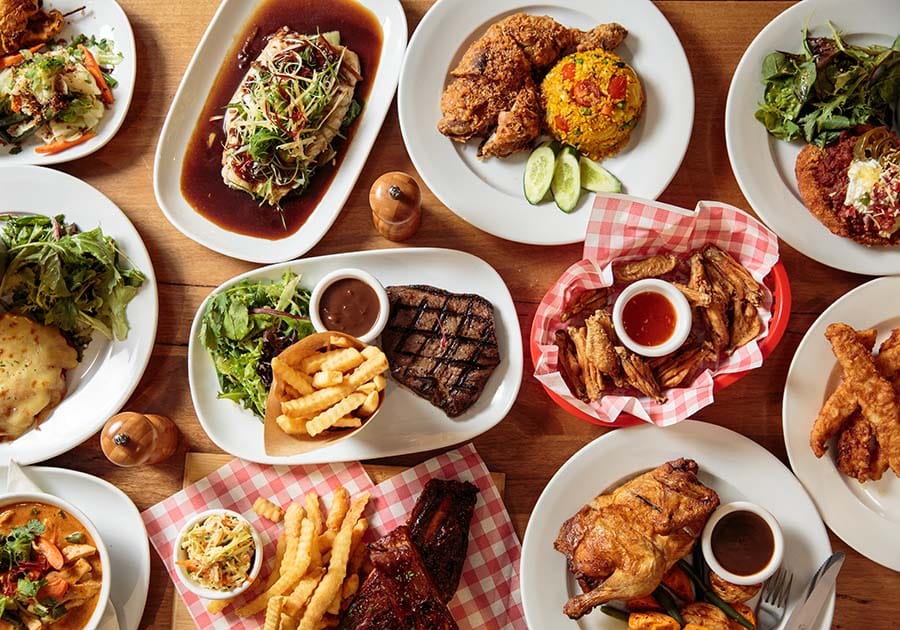
home-cooked / homemade food: thức ăn nấu ở nàh
processed food = a ready meal: đồ ăn làm sẵn
a takeaway: đồ ăn mang về
a quick snack: ăn xế
local specialty (US) hoặc speciality (UK): đặc sản địa phương
delicacy: sơn hào hải vị, món ăn độc đáo & đặc sắc
staple food: thực phẩm chính, ăn mỗi ngày
canned food: thực phẩm đóng hộp
cereals: ngũ cốc ăn sáng
seasonings: gia vị (salt, pepper or spices added to food)
organic food: thực phẩm hữu cơ (food that is produced without using harmful chemicals)
vegetarian food = plant-based diets = meat-free meals = all-vegetable meals: đồ ăn chay
meat-based diets = vegetable-free diets = all-meat meals: chế độ ăn toàn thịt, không rau củ
junk food: đồ ăn vặt loại không bổ dưỡng.
3-course meal: bữa ăn gồm 3 món: starter/ appetizer (khai vị), main course (món chính) and dessert (tráng miệng).
Các tính từ đồng nghĩa với 'delicious':
Scrumptious /ˈskrʌmp.ʃəs/ (a): tasting extremely good; delicious
E.g: This cake is scrumptious that I cannot stop myself from eating another piece.
Delectable /dɪˈlek.tə.bəl/ (a):
E.g: The restaurant serves delectable food. Everything is good
Appetizing /ˈæp.ə.taɪ.zɪŋ/ (a):
E.g: Your dessert looks appetizing. I should have ordered the same.
Tasty (a): /ˈteɪ.sti/ (>< tasteless)
E.g: This is a very tasty ice cream
Flavourful /ˈfleɪ.vɚ.fəl/ (a) (>< flavourless)
E.g: a flavourful sauce
Mouth-watering (a)
E.g: You bread looks mouth-watering
Các tính từ khác miêu tả mùi vị thức ăn:
Sweet (ngọt) >< bitter /ˈbɪt̬.ɚ/ (đắng) , sour /saʊr/ (chua)
Hot, spicy (cay, nồng) >< mild, bland, tasteless, flavourless (nhạt nhẽo, không có mùi vị)
Salty (mặn chát) >< sugary (ngọt gắt)
Greasy /ˈɡriː.si/, oily (nhiều dầu) >< dried (khô)
Lean [has little or no fat] (nạc, không mỡ) >< fatty [has a lot of fat] (nhiều mỡ)
Các cụm động từ miêu tả cách ăn uống:
To overeat = Eat too much: Ăn quá nhiều
E.g: If you overeat, you’re bound to get fat.
A fussy/ picky eater: người ăn uống kén chọn, khó ăn >< an easy eater: người dễ ăn
To have a sweet tooth = to enjoy sugary food: thích ăn đồ ngọt
To be full up = to eat to the point that you can no longer eat any more: no căng bụng
To dine in/ eat in = to have main meals at home: Ăn cơm ở nhà
To dine out/ eat out = to have main meals out: Ăn ngoài
E.g: I’d prefer to dine in with my husband rather than dine out with my colleagues.
To grab something to eat: to eat something quickly (when you’re in a rush): ăn vội vàng vì bạn đang vội
Các cụm từ nói về dinh dưỡng:
To be on a balanced/moderate diet = Eat in a healthy diet: Ăn uống điều độ
Eg: I have a crack at following a balanced diet so that I can live healthily and live longer.
Diet (n): chế độ ăn | Meal (n): bữa ăn | Portion (n): khẩu phần ăn
nutritional benefits: lợi ích dinh dưỡng (an advantage gained from substances that are essential for good health and growth)
nutritional values: giá trị dinh dưỡng
nutritional balance: cân bằng dinh dưỡng
to be sufficient nutritionally: đầy đủ dinh dưỡng
nutrient(s): (các) chất dinh dưỡng
nutritious (a): bổ dưỡng e.g: nutritious food
health consciousness: ý thức giữ gìn sức khỏe (being aware of how to maintain the state of being free from illness or injury)
to get obese: trở nên béo phì (to become grossly fat or overweight)
to gain/ lose weight: tang/ giảm cân
health awareness: nhận thức về sức khỏe (knowledge or perception of how to maintain the state of being free from illness or injury)
addicting effect: hiệu ứng gây nghiện (a change resulting in being addicted to a particular substance, thing, or activity)
What is a balanced diet?
Do you think a balanced diet is important?
What is a typical diet of people in your country?
Do you think most people in your country eat healthily?
Do many people eat in restaurants in your country?
What's the difference between restaurant food and home-cooked food?
Why do some people enjoy eating out?
Why do some people enjoy eating at home?
Ready-made food and home-made food differ on their benefits.
In terms of dishes cooked at home, tastes and flavours of such food are usually better because it is freshly cooked, instead of pre-prepared and frozen food reheated in restaurants. Also, home cooking is individually oriented so food will taste like what we personally want. In addition, home-made food is self-prepared so we exactly what we're gonna eat.
Turning to food cooked at restaurants, this kind of food introduces a variety of options for eaters. People can taste delicacies of various cuisines just by visiting eateries. Also, some good restaurants with proper food safety serve delectable dishes, which is very helpful for those who have a tight schedule and not good at cooking.
Do you think that cooking is a pleasure or a burden for most people?



